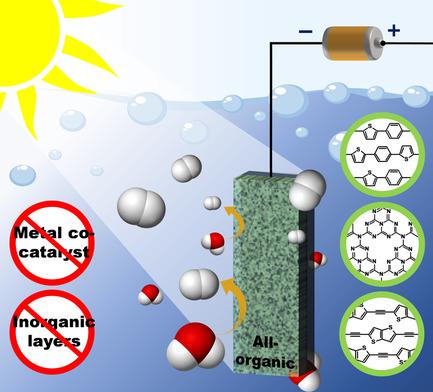Our official English website, www.x-mol.net, welcomes your
feedback! (Note: you will need to create a separate account there.)
Pure Organic Semiconductor‐Based Photoelectrodes for Water Splitting
Solar RRL ( IF 6.0 ) Pub Date : 2019-12-03 , DOI: 10.1002/solr.201900395 Sultan Otep 1, 2 , Tsuyoshi Michinobu 1 , Qichun Zhang 2
Solar RRL ( IF 6.0 ) Pub Date : 2019-12-03 , DOI: 10.1002/solr.201900395 Sultan Otep 1, 2 , Tsuyoshi Michinobu 1 , Qichun Zhang 2
Affiliation

|
Currently, photoelectrochemical water‐splitting research is dominated by inorganic and organic–inorganic hybrid photoelectrodes. Although organic semiconductors have several advantages over their inorganic counterparts, the development of photoelectrodes based on pure organic materials has been lagging for the last decade. Recent improvements in molecular design, synthesis, and processing of organic semiconductors, such as polythiophenes, graphitic carbon nitrides, conjugated acetylenic polymers, alternating donor–acceptor‐conjugated polymers, and N‐containing fused‐ring small molecules, significantly enhance the performance of these photolectrodes without added cocatalysts. Although this research has been conducted over the past few years, this overlooked topic still stays unexplored, with more efficient materials yet to be discovered. Herein, the early development and recent advances of exclusively organic photoelectrodes for water splitting are summarized and brief perspectives for future improvements are provided.
中文翻译:

基于纯有机半导体的水分解光电极
目前,光化学水分解研究主要是无机和有机-无机混合光电极。尽管有机半导体相对于无机半导体具有一些优势,但是在过去的十年中,基于纯有机材料的光电极的发展一直滞后。聚噻吩,石墨碳氮化物,共轭炔聚合物,交替的供体-受体共轭聚合物和含氮稠环小分子等有机半导体的分子设计,合成和加工方面的最新改进,显着增强了这些聚合物的性能。无需添加助催化剂的光电电极。尽管这项研究是在过去几年中进行的,但是这个被忽视的话题仍然没有被探索,更有效的材料还有待发现。在此处,
更新日期:2019-12-03
中文翻译:

基于纯有机半导体的水分解光电极
目前,光化学水分解研究主要是无机和有机-无机混合光电极。尽管有机半导体相对于无机半导体具有一些优势,但是在过去的十年中,基于纯有机材料的光电极的发展一直滞后。聚噻吩,石墨碳氮化物,共轭炔聚合物,交替的供体-受体共轭聚合物和含氮稠环小分子等有机半导体的分子设计,合成和加工方面的最新改进,显着增强了这些聚合物的性能。无需添加助催化剂的光电电极。尽管这项研究是在过去几年中进行的,但是这个被忽视的话题仍然没有被探索,更有效的材料还有待发现。在此处,











































 京公网安备 11010802027423号
京公网安备 11010802027423号